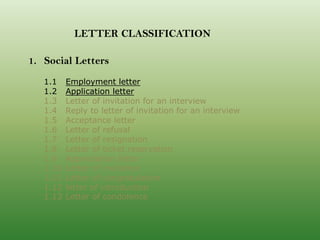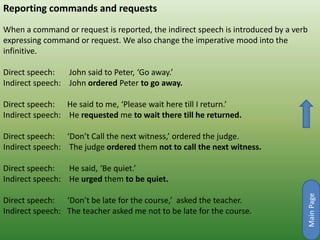Business letter
- 1. Course Summary of English Correspondence BUSINESS LETTER GRAMMAR FOCUS: Command & Request Possession of Adjectives
- 2. LETTER CLASSIFICATION 1. Social Letters 1.1 1.2 1.3 1.4 1.5 1.6 1.7 1.8 1.9 1.10 1.11 1.12 1.13 Employment letter Application letter Letter of invitation for an interview Reply to letter of invitation for an interview Acceptance letter Letter of refusal Letter of resignation Letter of ticket reservation Appreciation letter Letter of invitation Letter of congratulation letter of introduction Letter of condolence
- 3. LETTER CLASSIFICATION 2. BUSINESS LETTER 2.1 Inquiry letter 2.2 Reply to inquiry 2.3 Order letter 2.4 Reply to order 2.5 Complaint letter 2.6 Adjustment letter 2.6 Collection letter 2.7 Insurance letter 2.8 Credit letter 2.9 Banking letter
- 4. FORMS OF BUSINESS LETTER 1. Block Style 2. Full-Block Style 3. Semi-Block Style 4. Hanging Style 5. Indented Style
- 7. Sample Letter of Inquiry The Virtual Community Group, Inc. 17 Park Road Rural Town, NH May 23, 2012 Jane Smith, Executive Director Xavier Foundation 555 S. Smith St. Washington, D.C. 22222 Dear Ms. Smith, I am writing to inquire whether the Xavier Foundation would invite a proposal from the Virtual Community Group, Inc., requesting an investment of $50,000 per year over two years to support our Enterprise 2000 initiative We believe that broadly-implemented technical skills programs such as Enterprise 2000 have the potential to transform the lives of many struggling entrepreneurs, and change the economic landscape of impoverished rural communities. With your support, we can make that 10% difference in the lives of these hard-working people and the future of our rural communities. Please feel free to call me with any questions. I look forward to hearing from you soon. Sincerely, Executive Director
- 8. Order letter sample May 13, 2012 Mrs. Erlinda Ramos MGT Marketing Abucay, Bataan Dear Mrs. Ramos: Enclosed is a money order for two hundred dollar ($200) in return for which please send me by parcel post: 1 piece bathing suit, navy blue and white, size 33, No. H61 – $60.00 1 pair of white canvas tennis shoes, crepe soles, size 4, C width – $40.00 1 Tilden tennis rocket, green and white trim, green strings, wt. 13 oz., handle 4 inches – $45.00 1 grey sweater, V-neck, size 28, No. B25 – $55.00 Please send these articles within five days. Very truly yours, Mr. Roderick Santos
- 9. Complaint letter sample 65 Market Street Val Haven, CT 95135 May 23, 2012 Customer Service Cool Sports, LLC 8423 Green Terrace Road Asterville, WA 65435 Dear Sir or Madam: I have recently ordered a new pair of soccer cleats (item #6542951) from your website on June 21. I received the order on June 26. Unfortunately, when I opened it, I saw that the cleats were used. My order number is AF26168156. To resolve the problem, I would like you to credit my account for the amount charged for my cleats; I have already went out and bought a new pair of cleats at my local sporting goods store so sending another would result in me having two pairs of the same cleats. Thank you for taking the time to read this letter. I have been a satisfied customer of your company for many years and this is the first time I have encountered a problem. If you need to contact me, you can reach me at (555) 555-5555. Sincerely, Ken Thomas
- 10. Parts of English business letter 1. Heading/letterhead : The company and address for sender 2. Dateline 3. Reference Line : Initial the signaturer and the letter's typist 4. Inside Address : The name and address for receiver 5. Attention Line : The name or important thing 6. Salutation 7. Body of letter : Opening, content, and closing 8. Complimentary Close 9. Enclosure
- 11. Reporting a question, command or request In reporting a question, the indirect speech is introduced by verbs such as asked, inquired etc. When the question is not introduced by an interrogative word, the reporting verb is followed by if or whether. Direct speech: He said to me, ‘Where are you going?’ Indirect speech: He asked me where I was going. (NOT He asked me where was I going.) Direct speech: The policeman said, ‘What are you doing?’ Indirect speech: The policeman asked what I was doing. (NOT The policeman asked what are you doing.) Direct speech: ‘Where do you live?’ said the stranger. Indirect speech: The stranger asked where I lived. Direct speech: He said, ‘Will you help me?’ Indirect: He asked me if I would help him. Direct speech: ‘Do you think you know better than your father?’ jeered the angry mother. Indirect speech: His angry mother jeered and asked him whether he thought he knew better than his father.
- 12. Reporting commands and requests When a command or request is reported, the indirect speech is introduced by a verb expressing command or request. We also change the imperative mood into the infinitive. Direct speech: John said to Peter, ‘Go away.’ Indirect speech: John ordered Peter to go away. Direct speech: He said to me, ‘Please wait here till I return.’ Indirect speech: He requested me to wait there till he returned. Direct speech: ‘Don’t Call the next witness,’ ordered the judge. Indirect speech: The judge ordered them not to call the next witness. Direct speech: ‘Don’t be late for the course,’ asked the teacher. Indirect speech: The teacher asked me not to be late for the course. Main Page Direct speech: He said, ‘Be quiet.’ Indirect speech: He urged them to be quiet.
- 13. Using Possessive Pronouns Use the possessive pronouns my, your, her, his, its, our, and their to modify the nouns that follow. These possessive pronouns function as adjectives in sentences. Main Page His advice about avoiding e-mail viruses was valuable. We prefer to e-mail our company newsletter. Change your password by Friday.
- 14. Using Possessive Pronouns Do not use the possessive pronouns mine, yours, his, hers, ours, and theirs as modifiers before nouns. These pronouns stand alone and are separated from the nouns to which they refer. Main Page The responsibility is yours if an attachment with a virus is opened. His was the only e-mail message that I read today.















